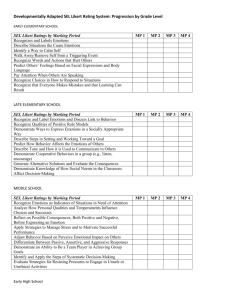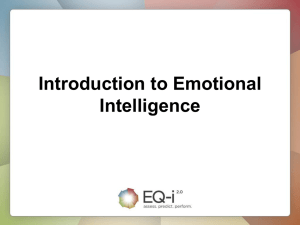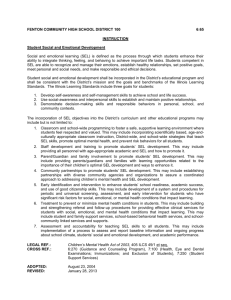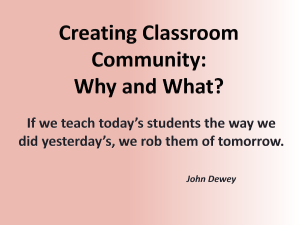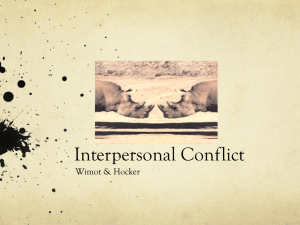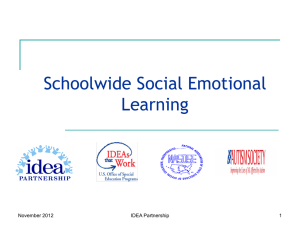SEL Goals/Descriptors
advertisement
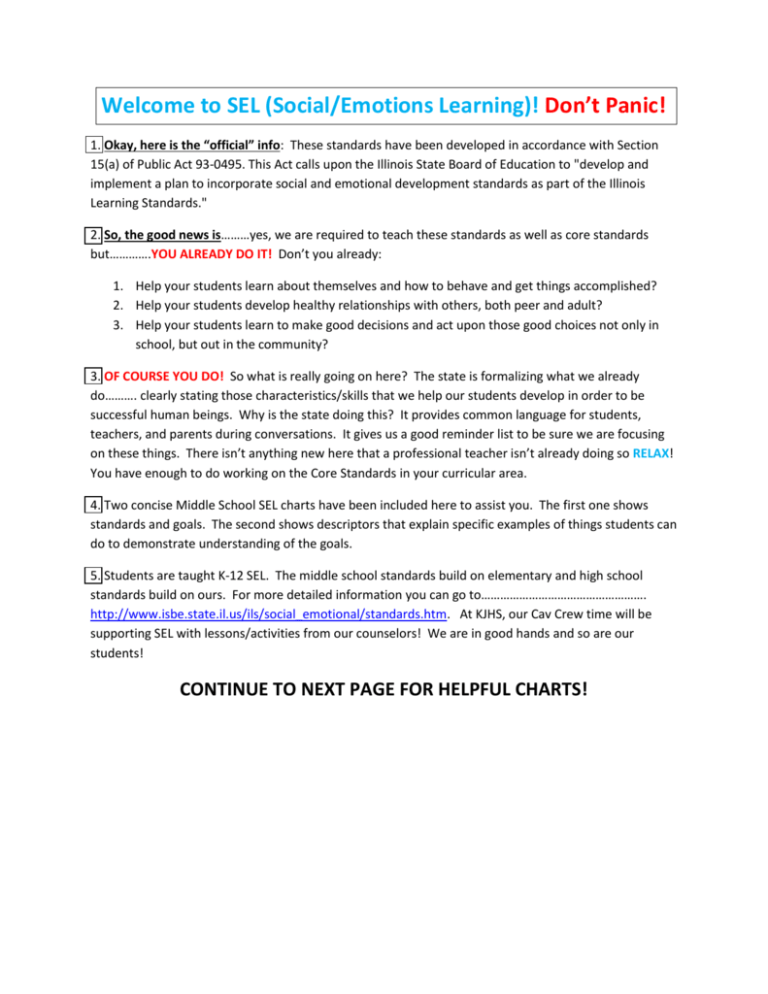
Welcome to SEL (Social/Emotions Learning)! Don’t Panic! 1. Okay, here is the “official” info: These standards have been developed in accordance with Section 15(a) of Public Act 93-0495. This Act calls upon the Illinois State Board of Education to "develop and implement a plan to incorporate social and emotional development standards as part of the Illinois Learning Standards." 2. So, the good news is………yes, we are required to teach these standards as well as core standards but………….YOU ALREADY DO IT! Don’t you already: 1. Help your students learn about themselves and how to behave and get things accomplished? 2. Help your students develop healthy relationships with others, both peer and adult? 3. Help your students learn to make good decisions and act upon those good choices not only in school, but out in the community? 3. OF COURSE YOU DO! So what is really going on here? The state is formalizing what we already do………. clearly stating those characteristics/skills that we help our students develop in order to be successful human beings. Why is the state doing this? It provides common language for students, teachers, and parents during conversations. It gives us a good reminder list to be sure we are focusing on these things. There isn’t anything new here that a professional teacher isn’t already doing so RELAX! You have enough to do working on the Core Standards in your curricular area. 4. Two concise Middle School SEL charts have been included here to assist you. The first one shows standards and goals. The second shows descriptors that explain specific examples of things students can do to demonstrate understanding of the goals. 5. Students are taught K-12 SEL. The middle school standards build on elementary and high school standards build on ours. For more detailed information you can go to……………………………………………. http://www.isbe.state.il.us/ils/social_emotional/standards.htm. At KJHS, our Cav Crew time will be supporting SEL with lessons/activities from our counselors! We are in good hands and so are our students! CONTINUE TO NEXT PAGE FOR HELPFUL CHARTS! Social/Emotional Learning Standards INTRODUCTION Social and emotional learning (SEL) is the process through which children develop awareness and management of their emotions, set and achieve important personal and academic goals, use social-awareness and interpersonal skills to establish and maintain positive relationships, and demonstrate decision making and responsible behaviors to achieve school and life success. There is a strong research base indicating that these SEL competencies improve students’ social/emotional development, readiness to learn, classroom behavior, and academic performance. The SEL goals, standards, and benchmarks were initially developed by a broadly representative group of teachers, school administrators, student support staff, human services professionals, and parents with expertise in child development and learning, curriculum design, and instruction. After the standards were written, public comment and feedback provided the writing team with information used in revising the standards before adoption by the ISBE. Criteria for SEL Standards: The standards and benchmarks were expected to meet the following criteria: • Be clear and meaningful to educators, students, parents and the community • Include an appropriate combination of knowledge and skills • Be specific enough to convey what students should learn, but broad enough to allow for a variety of approaches to teaching and aligning curriculum • Be specific enough to allow for classroom assessments to measure student progress Goal 1: Develop self-awareness and self-management skills to achieve school and life success. A. Identify and manage one’s emotions and behavior. 1A.3a. Analyze factors that create stress or motivate successful performance. 1A.3b. Apply strategies to manage stress and to motivate successful performance B. Recognize personal qualities and external supports. 1B.3a. Analyze how personal qualities influence choices and successes. 1B.3b. Analyze how making use of school and community supports and opportunities can contribute to school and life success. C. Demonstrate skills related to achieving personal and academic goals. 1C.3a. Set a short-term goal and make a plan for achieving it. 1C.3b. Analyze why one achieved or did not achieve a goal. Goal 2: Use socialawareness and interpersonal skills to establish and maintain positive relationships. A: Recognize the feelings and perspectives of others. 2A.3a. Predict others’ feelings and perspectives in a variety of situations 2A.3b. Analyze how one’s behavior may affect others. B: Recognize individual and group similarities and differences. 2B.3a. Explain how individual, social, and cultural differences may increase vulnerability to bullying and identify ways to address it. 2B.3b. Analyze the effects of taking action to oppose bullying based on individual and group differences. C: Use communication and social skills to interact effectively with others. 2C.3a. Analyze ways to establish positive relationships with others. 2C.3b. Demonstrate cooperation and teamwork to promote group effectiveness. D. Demonstrate an ability to prevent, manage, and resolve interpersonal conflicts in constructive ways. 2D.3a. Evaluate strategies for preventing and resolving interpersonal Problems 2D.3b. Define unhealthy peer pressure and evaluate strategies for resisting it. Goal 3: Demonstrate decision-making skills and responsible behaviors in personal, school, and community contexts. A: Consider ethical, safety, and societal factors in making decisions. 3A.3a. Evaluate how honesty, respect, fairness, and compassion enable one to take the needs of others into account when making decisions. 3A.3b. Analyze the reasons for school and societal rules. B: Apply decision-making skills to deal responsibly with daily academic and social situations. 3B.3a. Analyze how decision-making skills improve study habits and academic performance. 3B.3b. Evaluate strategies for resisting pressures to engage in unsafe or unethical activities. C. Contribute to the well-being of one’s school and community. 3C.3a. Evaluate one’s participation in efforts to address an identified school need. 3C.3b. Evaluate one’s participation in efforts to address an identified need in one’s local community. Social/Emotional Descriptors Goal 1 - Develop self-awareness and self-management skills to achieve school and life success. 1A — Identify and manage one's emotions and behavior. 1. 2. 3. 4. 5. 6. Recognize emotions as indicators of situations in need of attention. Distinguish how you really feel from how others expect you to feel. Distinguish between different emotions (e.g., fear and anger, shame and sadness). Analyze emotional states that contribute to or detract from your ability to solve problems. Analyze the effect of self-talk on emotions. Practice self-calming techniques (deep breathing, self-talk, 7. progressive relaxation, etc.) to manage stress. Demonstrate an ability to process emotions to facilitate problemsolving (e.g., overcome negativity, and develop a positive attitude). 1B — Recognize personal qualities and external supports. 1. 2. 3. 4. 5. 6. Identify extra-curricular activities available to students. Recognize the outside influences on development of personal characteristics (e.g., body image, self-esteem, behavior). Identify school support personnel and investigate how they assist students. Identify organizations in your community that provide opportunities to develop your interests or talents. Evaluate the benefits of participating in extra-curricular activities (e.g., friendship, leadership, learning new skills, teamwork). Evaluate how your physical characteristics have contributed to decisions you have made (e.g., what sports to play, what activities to participate, etc.). 1C — Demonstrate skills related to achieving personal and academic goals. 1. 2. 3. 4. 5. 6. Identify resources to help progress towards a goal (e.g., research materials). Analyze how barriers and supports influenced the completion of action steps toward achieving a goal. Analyze how you might have made better use of supports and overcome obstacles in working on a recent goal. istinguish between a short and long-term goal. Apply goal-setting skills to develop academic success. Set a positive social interaction goal. Goal 2: Use social-awareness and interpersonal skills to establish and maintain positive relationships. 2A — Recognize the feelings and perspectives of others. 1. 2. 3. 4. 5. 6. Identify the feelings and perspective of others during group discussions. Recall a situation where your behavior impacted the feelings of others either positively or negatively. Describe how classmates who are the subject of rumors or bullying might feel. Distinguish between bullying and non-bullying situations. Role-play the perspectives of various characters in scenarios provided. Paraphrase the conflicting perspectives of parties to a conflict. 2B — Recognize individual and group similarities and differences. 1. 2. Investigate the traditions of others (e.g. memorize phrases from other languages, familiarize yourself with the music or cuisine of other cultures). Identify negative depictions of differences among people (e.g., 3. 4. 5. 6. gender or sexual orientation stereotyping, discrimination against socio-economic or culture minorities, prejudices based on misinformation) in readings completed for coursework. Explain how a lack of understanding of social and cultural differences can contribute to intolerance. Evaluate ways of overcoming a lack of understanding of those who are different. Explain why bullying or making fun of others is harmful to oneself or others (e.g., physical or verbal). Listen respectively to opposing points of views on controversial issues. 2C — Use communication and social skills to interact effectively with others. 1. 2. 3. 4. 5. 6. Role-play how to report bullying behavior. Participate in setting and enforcing class rules. Practice strategies for maintaining positive relationships (e.g., pursuing shared interests and activities, spending time together, giving and receiving help, practicing forgiveness). Recognize the importance of setting limits for yourself and others. Demonstrate an ability both to assume leadership and be a team player in achieving group goals. Learn to maintain an objective, non-judgmental tone during disagreements. 2D — Demonstrate an ability to prevent, manage, and resolve interpersonal conflicts in constructive ways. 1. 2. 3. 4. 5. 6. Identify factors that contribute to violence (e.g., inappropriate management of anger and the availability of instruments of violence). List characteristics of friends who are a healthy or unhealthy influence. Identify strategies for avoiding, sidestepping, and reducing violence. Brainstorm destructive behaviors encouraged by peers (e.g., drugs, gossip, sexual behaviors, self-destructive behavior, etc.). Analyze the causes of a physical or verbal fight that you observed and prevention strategies. Practice negotiation skills in pairs, taking the perspective of both parties into account. Goal 3: Demonstrate decision-making skills and responsible behaviors in personal, school, and community contexts. 3A — Consider ethical, safety, and societal factors in making decisions. 1. 2. 3. Identify safe alternatives to risky behaviors (e.g., riding in a car with a drunk driver, riding a skate board in a dangerous place, resisting smoking or drugs). Describe common socially accepted behavior in a variety of situations (e.g. attending a football game or concert joining a new group, going to a job interview, participating in class, etc.). Define the roles of responsibility as a victim, bystander, perpetrator, rescuer in a situation. 4. 5. 6. Assess one's own risk for various types of injury. Make journal entries on how your actions have affected others. Judge the seriousness of unethical behaviors (e.g., cheating, lying, stealing, plagiarism, etc.). 3B — Apply decision-making skills to deal responsibly with daily academic and social situations. 1. 2. 3. 4. 5. 6. 7. List qualities that contribute to friendships. Describe the effects of procrastination and disorganization on academic outcomes. Analyze how decision-making skills improve your study habits. Analyze each step of a decision-making process used in responding to problem scenarios. Reflect in your journal on the consequences of your recent risktaking behavior. Use a decision log for 24 hours to identify influences on your health decisions. Demonstrate refusal skills. 3C — Contribute to the well-being of one's school and community. 1. 2. 3. 4. 5. 6. 7. Identify sources of information about your community. Identify responsibilities of citizenship (e.g., obeying laws, serving on juries, being informed about issues, being involved in influencing public policy). Analyze what you learned about yourself and the community from involvement. In a community improvement activity. Analyze the consequences of participating or not participating in the electoral process. Collect information about how groups are working to improve the community. Evaluate a recent project that addressed a community need or issue. Make a plan with your family to participate in a community improvement activity.
